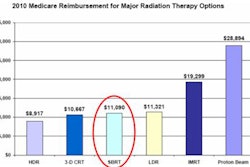Few women older than 70 who are diagnosed with early-stage breast cancer without lymph node involvement need radiation therapy (RT) after having a lumpectomy, according to the most recent findings of a large multi-institutional trial to be presented next month at the American Society of Clinical Oncology (ASCO) meeting.
According to the study, adding radiation therapy only reduced the risk of breast cancer recurrence by approximately 6%. Women who took tamoxifen following breast conservation surgery had the same odds of survival as those who underwent radiation therapy and took tamoxifen. Both groups of women were 95% disease-free 10 years after treatment.
Although the value of radiation therapy for low-risk, early-stage breast cancers in elderly women has been debated for at least a decade, the data presented by the clinical trial's principal investigator, Dr. Kevin Hughes, at a press conference held by ASCO was lauded as "practice-altering and potentially practice-changing" by Dr. Douglas Blayney, ASCO's president. The press conference highlighted a selection of important scientific sessions to be presented at the society's forthcoming annual meeting being held in Chicago June 4-8.
Hughes, a breast surgeon and co-director of Massachusetts General Hospital's Avon Foundation Comprehensive Breast Evaluation Center in Boston, led a clinical trial in which 10 academic cancer centers enrolled 636 women. Eligible women were older than 70, with stage I estrogen-receptor-positive (or indeterminate) breast cancer, a tumor no larger than 4 cm in diameter, clear margins, and no nodal involvement.
Patients randomly assigned to receive radiation therapy received 25 daily fractions of 1.8 Gy, for a total 45-Gy radiation dose to the entire breast. This treatment was followed by an electron boost to the primary tumor site of up to 14 Gy, given in seven fractions of 2 Gy per day. All of the women enrolled in the trial took 20 mg of tamoxifen per day for five years.
The Cancer and Leukemia Group B (CALGB) study C9343 was designed in cooperation with the Eastern Cooperative Oncology Group (ECOG) and the Radiation Therapy Oncology Group (RTOG). The study began in 1994 and enrollment was closed in February 1999.
A total of 36 women developed recurrent cancer in the same breast. Twenty-six women were in the tamoxifen-only patient cohort. The risk of breast cancer recurrence was 2% for the women who received radiation therapy, compared with 8% for those who did not.
"At a median 12 years following treatment, radiation therapy did have some benefits of in-breast recurrence, but those benefits are small," Hughes said. "We would have had to irradiate 319 women to prevent 20 from having had breast cancer recurrences. Those who did develop subsequent in-breast cancer could have opted for another lumpectomy followed by radiation."
Hughes reported that breast-cancer-specific survival for women who received only tamoxifen was 98%. It was 2% less for women who received radiation therapy, and was not statistically significant.
Twelve women in the group that received radiation therapy died from their disease, and eight died in the tamoxifen-only group. The difference was not statistically significant, according to Hughes. Approximately 40% of the women who participated in the study have died, the majority from natural causes of old age or other illnesses.
Hughes pointed out that if the clinical trial was started today, cancer recurrence may have been even lower. "In the 1990s clear margins were defined as 'no ink on tumor' one cell negative margin. Clear margins today are defined as being within the 1- to 2-mm range."
Blayney commented that because patients are dying of other causes and old age, the study seemed close to being conclusive. "It is the kind of study that would not typically be done with assurance if we relied on industries to sponsor clinical trials like this," he said.
"It is worth pointing out that diagnosing older women with smaller tumors that are estrogen-receptor positive without evidence of spread to the lymph nodes is a fairly common situation in the practice of breast cancer oncology," he said. "For almost 20 years, my colleagues and I have discussed the relative benefits of radiation therapy with older women. Many of these women elect to defer radiation therapy. This study gives us some comfort as physicians in supporting this decision on our patients' behalf." Blayney currently practices at the University of Michigan Comprehensive Cancer Center in Ann Arbor, where he is the medical director.
"Tamoxifen alone is a reasonable choice for adjuvant treatment in such women. Patients and their physicians should weigh the slightly increased risk of local recurrence against the cost, inconvenience, and adverse effects of irradiation. The choice of treatment should take into account the needs of the patient," Hughes and clinical trial colleagues wrote in an article published in 2004 about the study (New England Journal of Medicine, September 2, 2004, Vol. 351:10, pp. 971-977).
This same recommendation remains true today.
By Cynthia E. Keen
AuntMinnie.com staff writer
May 21, 2010
Related Reading
MRI finds undetected tumors in second breast of older women, March 17, 2010
DCIS recurrence rates higher in younger women, October 7, 2009
Breast cancer risk assessment warranted in older women, March 11, 2009
Mammography benefits may have no age limit, April 22, 2008
Screening mammograms for elderly women encouraged, January 16, 2008
Copyright © 2010 AuntMinnie.com



















